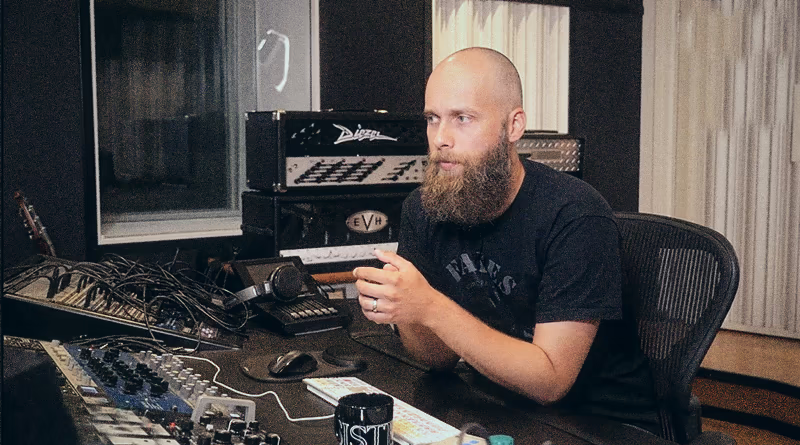
Dry Tracking Drums: Josh Schroeder’s Method for Tallah’s Snare Tone
Nail The Mix Staff
Getting the snare drum right is arguably one of the most critical—and frustrating—parts of a modern metal mix. It needs to cut, crack, and have body, all while navigating a dense wall of guitars and vocals. In his session mixing Tallah, powerhouse producer Josh Schroeder breaks down his philosophy of “dry tracking” drums, an approach that prioritizes ultimate control over everything else.
Forget massive, booming room mics. Josh’s method is about capturing a tight, focused source sound and then building the space and impact yourself. Let’s dive into how he uses this technique, from mic choice to some slick audio-to-MIDI tricks, to craft a killer snare sound.
The “Dry Tracking” Philosophy: Control Is King
While the epic, natural ambience of a huge drum room sounds amazing in theory, it can be a real headache in the mix. Josh explained that his current drum room is intentionally smaller and more controlled. He learned from past experiences that he’d rather have a more deadened, dampened drum sound to start with and then build the perfect “room” sound himself.
This gives him total control to augment the kit with custom-made samples, blending them to fit the song perfectly. It’s a trade-off: less initial “vibe” for way more flexibility later. This approach allows for surgical precision, ensuring every element of the drum kit serves the mix exactly as intended.
Building the Snare Sound from the Ground Up
With a controlled source sound, the real work begins. Here’s how Josh builds the massive Tallah snare tone piece by piece.
The Core Mic Setup
You don’t need a locker full of exotic mics to get a pro sound. Josh’s setup is straightforward and effective.
- Top Mic: A Shure Beta 57. He prefers this over the standard SM57 because it feels more isolating and has better rejection of cymbal bleed, which is a constant battle in metal.
- Bottom Mic: A classic Shure SM57 is a perfect choice here to capture the snap and sizzle of the snares.
A cool detail he points out is how Tallah’s drummer, Max Portnoy, will flip the snare chain on and off with one hand during a roll. It’s these small performance details that you want your recording to capture clearly, and a tight micing setup helps those nuances come through.
Audio to MIDI: The Secret to Consistent Samples
This is where the magic really starts. Before any EQ or compression touches the raw snare track, Josh inserts an audio-to-MIDI trigger. He uses the stock plugin in Reaper to convert the transients from the top snare mic into MIDI notes.
Here’s why this is so clever:
- It’s Placed First: By putting the trigger before any other processing, the dynamics of the raw performance are preserved. Adding compression or EQ would change the transient’s shape and volume, which could make the MIDI triggering inconsistent. This way, he can mangle the audio track later without affecting the sample triggers.
- It Triggers a Sampler: The MIDI note (typically note 38, or D2, a standard for snare mapping) is then sent to a separate track hosting a sampler. In this case, Josh uses Reaper’s simple but powerful built-in sampler, ReaSamplOmatic5000.
Crafting the “Room” with Custom Samples
That triggered MIDI is now the brain for the snare’s larger-than-life sound. Josh loads his sampler with custom snare samples he made with Max. He even uses multiple instances of the sampler—one for a more standard reverb sound, and another, more processed “big verb” for adding extra “stank” to bigger moments.
To avoid the dreaded “machine gun” effect where every sample sounds identical, the sampler is often set to round-robin, cycling through slightly different recordings of the same snare.
And how do they get those over-the-top sounds? By doing ridiculous things you could never do during a take, like “beating the hell out of his snare with a rake” after all the main tracking is done. This captures a level of impact and velocity that’s impossible to achieve while playing a song, perfect for creating powerful, custom samples.
Processing the Live Snare Mics
Once the sample foundation is in place, it’s time to process the original mic tracks to blend them in.
Taming Bleed with Smart Gating
Hi-hat and cymbal bleed in the snare mics is inevitable. Instead of a hard gate that can sound choppy, Josh uses a multiband compressor, the FabFilter Pro-MB, as a more transparent “smart gate.” He sets it to duck the high frequencies by about 10dB between hits. This cleans up the bleed significantly without completely killing the natural ring and decay of the snare. This move becomes even more crucial once heavy bus compression is added, as that will bring up the noise floor and make any bleed much more apparent.
Shaping with EQ
The processing here is all about context. The bottom snare mic gets a healthy boost around 5kHz to bring out the “snap” of the wires. Listening in solo, this might sound harsh or thin, but within the full kit and the entire mix, it provides the exact texture and articulation needed so you don’t have to over-brighten the top mic and introduce more cymbal problems. This is a core principle of good EQ strategy.
Pro Tricks for Consistency and Workflow
Josh’s process is filled with smart habits that ensure a smooth and consistent production.
The Mix-As-You-Go Approach
Josh doesn’t wait until the end to mix. He works on the mix every day during the tracking process. By the time the band leaves after a month of recording, the mix is already about 90% complete. This ensures the song is evolving in the right direction from day one, and there are no big surprises during the final mixdown. You can see this entire process unfold in the full Tallah session.
Matching Drums Across Different Sessions
Tallah had older recordings from an EP that needed to be mixed alongside the new album tracks. The old drum tracks were far more dynamic. To make them match the new, heavily-driven sound, Josh used a UAD 610 Preamp plugin. He pushed it hard to emulate the sound of his Neve preamps clipping, effectively smashing the old snare track to give it a similar compressed, squared-off waveform as his new recordings. It’s a brilliant trick for bringing disparate recordings into the same sonic world.
Using Samples as a Tuning Reference
Throughout the long tracking process, drum tuning can drift. To keep things consistent, Josh records a clean hit of the snare into a “Samples” region of his project. He can then easily reference that original tuning against a new take, ensuring that a fill punched in a week later doesn’t sound out of place.

100+ Insanely Detailed Mixing Tutorials
We leave absolutely nothing out, showing you every single step
Learn from the Pros at Nail The Mix
These techniques offer a fantastic window into how a world-class producer like Josh Schroeder builds a crushing metal mix from scratch. Seeing the philosophy—control, consistency, and context—is one thing. But what if you could watch him do it, click-by-click, and get the multitracks to try it yourself?
Tallah on Nail The Mix
Josh Schroeder mixes "Overconfidence"
Get the Session
That’s what Nail The Mix is all about. You get to be a fly on the wall for the entire mixing session, with the actual producer explaining every plugin, every fader move, and every decision. If you’re ready to move beyond presets and learn how the pros truly craft their sound, check out the full session with Josh Schroeder and Tallah. It’s time to unlock your sound and make your mixes hit harder than ever.
Get a new set of multi-tracks every month from a world-class artist, a livestream with the producer who mixed it, 100+ tutorials, our exclusive plugins and more
Get Started for $1





